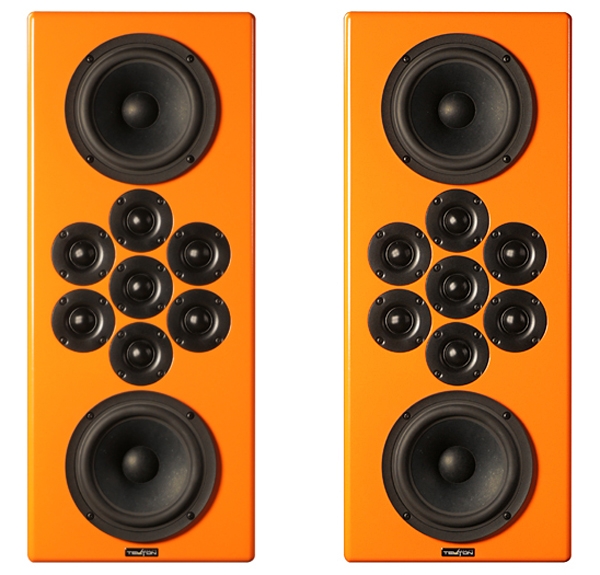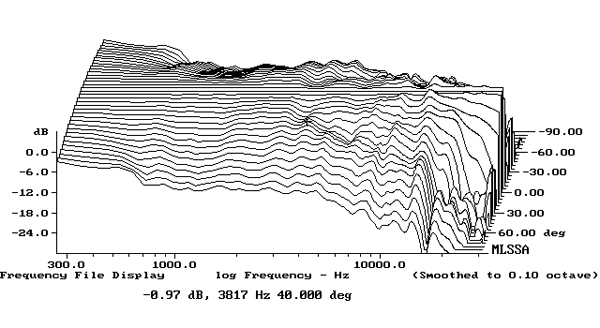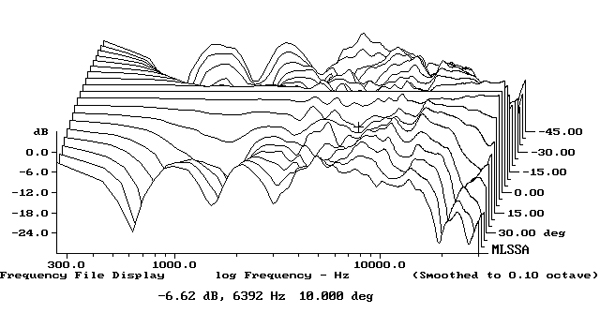Hi Everyone,
Stereophile just published a review of the Tekton Double Impact Monitors. I have never heard them, but I find the measurements iincredibly useful for talking about comb filtering.

Take a look at the horizontal dispersion:

This is really superb. No evidence here of any comb filtering from the seven tweeter array. But take a look at the vertical dispersion:

Now we have clear comb filtering occurring due to the woofer spacing. See the nulls at around 600 Hz, 1,800 Hz and the hash above it.
Thoughts?
Erik
Stereophile just published a review of the Tekton Double Impact Monitors. I have never heard them, but I find the measurements iincredibly useful for talking about comb filtering.

Take a look at the horizontal dispersion:

This is really superb. No evidence here of any comb filtering from the seven tweeter array. But take a look at the vertical dispersion:

Now we have clear comb filtering occurring due to the woofer spacing. See the nulls at around 600 Hz, 1,800 Hz and the hash above it.
Thoughts?
Erik
Measurements are as expected. Only the central tweeter handles top spectrum, so no bad surprises here at horizontal dispersion. But top and bottom tweeter (high mid, really) are doing more harm than good, separating woofers too much and producing strong comb filtering. Without the top and bottom tweeter (and bringing the woofers closer) this will be a good and almost original design.
That's really strange performance.
Based on the review, the designer indicates that the seven tweeter array is setup like a coaxial: the ring of six tweeters are not playing full range, only the center tweeter is.
This is definitely "gimmicky"; a conventional coax can accomplish the same thing at a much lower cost. You can get coaxes for about $50-$75 that will do this well, instead of using seven $30 neodymium tweeters like they did.
So, again, I think this is mostly an effort to be "different."
But the really poor vertical directivity is a bit of a mystery. I would expect things to be mostly symmetrical from 1khz to 20khz, but they're not.
Based on the review, the designer indicates that the seven tweeter array is setup like a coaxial: the ring of six tweeters are not playing full range, only the center tweeter is.
This is definitely "gimmicky"; a conventional coax can accomplish the same thing at a much lower cost. You can get coaxes for about $50-$75 that will do this well, instead of using seven $30 neodymium tweeters like they did.
So, again, I think this is mostly an effort to be "different."
But the really poor vertical directivity is a bit of a mystery. I would expect things to be mostly symmetrical from 1khz to 20khz, but they're not.
Patrick :
I think the problem is that the crossover between the tweeter array and woofers is not steep enough. D'Appolito himself has moved to higher order filters for just that reason.
As for coaxials - I haven't seen any as flat as these, but quite possibly as good sounding.
I think the problem is that the crossover between the tweeter array and woofers is not steep enough. D'Appolito himself has moved to higher order filters for just that reason.
As for coaxials - I haven't seen any as flat as these, but quite possibly as good sounding.
Horizontal looks no different compared to a regular 6.5"+1" 2-way with the tweeter crossed sufficiently low (~1.5kHz). At 90deg off axis the 6.5" drivers own responses will have a null at about 1.3kHz. If the tweeter is crossed low enough it will mostly fill the null (since the tweeter still has some output even below the crossover frequency) and that appears to be what is happening here. The same can be accomplished with a single tweeter that can cross commendably low. I would speculate that the aim here was just to use the additional six tweeters to beef up the low end and allow the crossover to the woofer to be lower. With 7 times the tweeter radiating area, the crossover frequency can be lowered about 50-60% at similar distortion levels. There is still a slight dip visible around 800-900Hz - perhaps the tweeters start operating about 1-1.5kHz. There does not appear to be an obvious attempt at controlling directivity (making the highs roll off faster off-axis) - looks almost identical to a single tweeter.
The vertical is bad below 1kHz because it's effectively an MTM configuration and the tweeter array has made the woofer to woofer spacing even worse. Given that the response in the low KHz is OK off the horizontal axis but not so good in the vertical, perhaps Erik is right that the crossover to the woofers is not steep enough.
Compared to a coaxial this array is better in the horizontal axis but much worse in the vertical. Coaxials have IMD problems due to the cone movement amplitude modulating the tweeter, which this design does not. They could have made things better in the vertical by moving both woofers to the bottom, running the bottom most one as 0.5way and making the top most tweeter the one that runs all the way up in frequency - horizontal performance would remain unchanged.
The vertical is bad below 1kHz because it's effectively an MTM configuration and the tweeter array has made the woofer to woofer spacing even worse. Given that the response in the low KHz is OK off the horizontal axis but not so good in the vertical, perhaps Erik is right that the crossover to the woofers is not steep enough.
Compared to a coaxial this array is better in the horizontal axis but much worse in the vertical. Coaxials have IMD problems due to the cone movement amplitude modulating the tweeter, which this design does not. They could have made things better in the vertical by moving both woofers to the bottom, running the bottom most one as 0.5way and making the top most tweeter the one that runs all the way up in frequency - horizontal performance would remain unchanged.
Last edited:
Tekton speakers are interesting, unconventional in many ways. All details eg. xo slopes are not revealed. The sad thing is temptation to tell stories like the patented principle of tweeter dome mass comparison to one of double bass's string weight...
Tekton is using up all the Beryllium!
ps. I like this!
Tekton is using up all the Beryllium!
ps. I like this!
An externally hosted image should be here but it was not working when we last tested it.
Last edited:
Only if you design the speaker to not take this into account. Remove the 7 tweet array, replace them with a 6" coax, reduce the W-W spacing and use decently steep filtering and IMD will not be a significant issue at any decent domestic level. H and V polars will also likely be much better too.Coaxials have IMD problems due to the cone movement amplitude modulating the tweeter
Since we're talking about D'Appolito arrangements, it should also be noted that for them to work properly in H and V axes, 3rd order acoustic filters should be used.
Later,
Wolf
Later,
Wolf
Around 2kHz if I know anything about 6" bass circuits. Don't know why John Atkinson would think 1kHz.Can we estimate crossover slopes from the impedance peaks and shape? 🙂
Tekton Design Impact Monitor loudspeaker Measurements | Stereophile.com
Philips have done a lot of work on arrays with varying level and polarities. For home cinema horizontal soundbars.
The simplest was the binomial array which goes 1-2-1 on level. Tekton did that one I think.
Less combing, more lobing. Actually, the diffraction falloff to the side or even above and below sounds much the same to my ears with MTM or MT.
I still think MTTM is the way to go. Either a ribbon tweeter or two small conventional ones. You get all the benefits of the 6dB gain.
Last edited:
- Status
- Not open for further replies.
- Home
- Loudspeakers
- Multi-Way
- Comb Filtering, arrays and bad D'Appolitos